The area around St. Anne’s, although not a residential neighborhood, has been a continuous center of French Canadian life in Berlin since 1881. With St. Anne’s Church, and later, St. Regis School, and St. Louis Hospital, the blocks bordered by Church, School and Main Street could be considered Berlin’s French Canadian “Town Square.” In its heyday, parishioners (St. Anne’s had 8,000 members in 1918), students (St. Regis had an enrollment of 1,300 students in 1911) and nuns made the area one of Berlin’s busiest spots.
Like Norwegians, French Canadians were first enumerated in Berlin’s 1860 census, after the arrival of the Grand Trunk Railroad– a largely Canadian line that connected Montreal with Portland, Maine. At that time, the handful of francophones consisted entirely of men living in boarding houses. Ten years later there were around a dozen French-Canadian families enumerated, in addition to the boarding house occupants. Thereafter growth in the number of French Canadians was exponential. Because they constituted such a high percentage of the population, there was never a single French Canadian neighborhood in Berlin —although some neighborhoods, like the St. Giles area, the East Side, “Little Canada” and The Avenues had a stronger French Canadian presence than others.
With this growth, and the increasing number of Catholic families from other backgrounds in Berlin, the parish of St. Anne’s was formed in 1867. The original St. Anne’s Church (left) was completed in November 1881, and was the first purpose-built church in Berlin. The church slightly predated the Congregational Church on Main Street in Berlin Mills Village which was designed by the same architects (Francis Fassett and partner John Calvin Stevens of Portland, ME). Within a short period (during which time St. Kieran’s parishioners had left St. Anne’s parish) old St. Anne’s was bursting at the seams and three services were necessary to accommodate worshipers. The answer lay in a new, larger church.
The March 23, 1900, Berlin Reporter announced that local architect A. I. Lawrence had completed plans and specifications for a larger, brick church. The church, it stated, “for size and elegance will rival any other structure of its kind in this section.” The design was anticipated to cost “upwards of $50,000” to complete. It was to be located on the site of the original church which was moved to another part of the block for use as a school.
The designer, A[rchibald] I[rving] Lawrence (1869-1950) was Berlin’s top architect of the era. After studying at the Massachusetts Normal Art School in Boston, he moved to Berlin in 1892. Early on, he partnered with L. U. Cole under the firm name of Cole & Lawrence; in the summer of 1894 the firm had 17 houses and public buildings under construction in Berlin. Lawrence started his own practice later that same year and went on to do many houses for wealthy or upper-middle class Berliners, including O.B. Brown’s house (corner Church and Hillside -demolished). He did a number of institutional buildings in Berlin in addition to St. Anne’s including: the Carnegie Library, the Burgess School/Notre Dame High School, and the Second Berlin High School. He also did a number of commercial blocks and the City National Bank. Elsewhere he designed churches, clubs, schools, town halls and a sanitarium. Lawrence moved to Burlington, VT in 1907. He was married to Bertha Stahl (daughter of Simon) from Gorham, NH. (See Cutter, 1914 New England Families Vol. III, p. 1631)
The contract to construct St. Anne’s was apparently let fairly soon after the plans were completed, as the first mass in the new church was held just a little over a year later on May 6, 1901. M.H. Roy, a Maine contractor was the builder. Father Louis M. LaPlant who was responsible for building St. Anne’s also helped to build the adjacent St. Regis Academy. The school began operation in another building in 1889, and the current building was completed in 1911 (J.B. Gilbert builder). The school had 20 classrooms and classes were held in French and English. Laplant was also the force behind the 63-bed St. Louis Hospital (1905) located next door to the School. The hospital ceased operation in 1978.
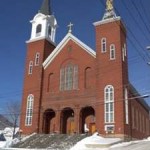 |
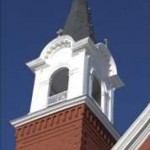 |
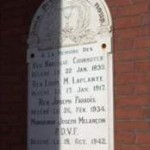 |
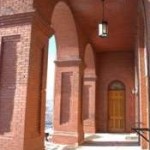 |
 |
 |

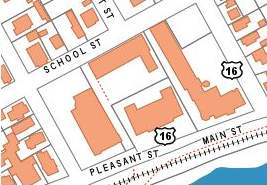

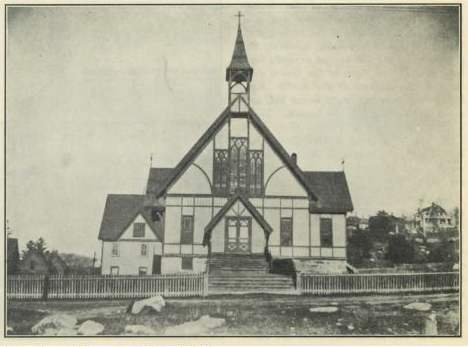
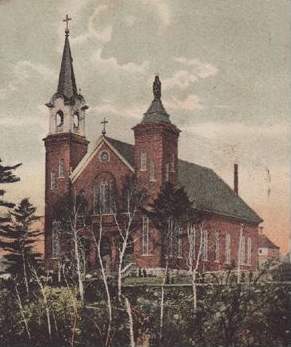
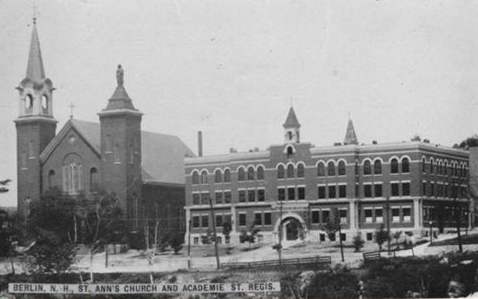
 Follow
Follow